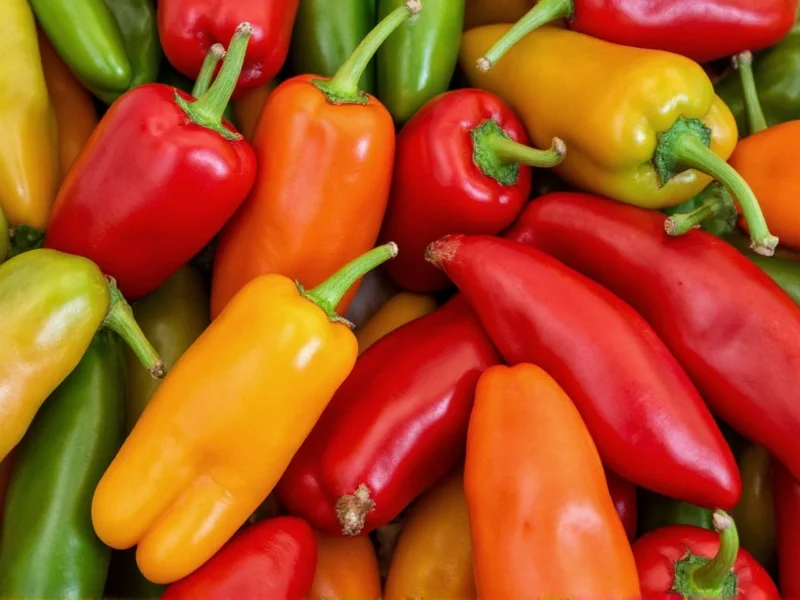Understanding bell pepper sweetness requires examining the ripening process and varietal differences. As bell peppers mature from green to their final color, complex biochemical changes occur that directly impact flavor. The transformation isn't merely cosmetic—it represents a fundamental shift in sugar composition and concentration.
The Science Behind Bell Pepper Sweetness
Bell peppers start life as green fruits, regardless of their eventual color. During ripening, chlorophyll breaks down while carotenoids develop, creating the vibrant yellow, orange, and red hues. Crucially, this process coincides with sugar accumulation. As peppers remain on the plant longer, they convert more starches to sugars, particularly fructose and glucose.
Research from agricultural universities shows that fully ripe yellow and orange bell peppers typically contain 5-6 grams of sugar per 100 grams, compared to 3-4 grams in green peppers. The extended vine-ripening period allows for maximum sugar development before the pepper transitions to red.
Bell Pepper Sweetness Comparison
Not all bell peppers deliver the same sweetness profile. The following table compares common varieties based on sugar content measurements from USDA agricultural studies:
| Pepper Color | Average Sugar Content (per 100g) | Ripening Stage | Sweetness Characteristics |
|---|---|---|---|
| Yellow | 5.8g | Mid-to-late ripening | Bright, honey-like sweetness with subtle citrus notes |
| Orange | 5.6g | Mid-to-late ripening | Complex sweetness with tropical fruit undertones |
| Red | 5.1g | Full ripeness | Rounded sweetness with mild fruitiness |
| Green | 3.3g | Immature | Grassy, slightly bitter with minimal sweetness |
| Purple | 4.2g | Specialty ripening | Mild sweetness with earthy notes (varies by variety) |
Factors Influencing Sweetness Beyond Color
While color provides a reliable indicator, several other factors affect bell pepper sweetness:
Specific Varietal Differences
Within each color category, certain cultivars naturally produce sweeter fruits. The Golden California Wonder yellow pepper and Orange Sun varieties consistently test higher in sugar content than standard yellow and orange peppers. Similarly, the Merlin red pepper variety often surpasses others in sweetness measurements.
Growing Conditions Matter
Sun exposure significantly impacts sugar development. Peppers grown with 8-10 hours of direct sunlight typically develop 15-20% more sugars than those in partial shade. Temperature also plays a role—consistent daytime temperatures between 75-85°F (24-29°C) optimize sugar production. Extreme heat above 90°F (32°C) can actually reduce sweetness.
Harvest Timing
The precise moment of harvest affects sweetness. Commercial growers often pick peppers slightly before peak ripeness for better shipping durability, which means supermarket peppers may not have reached maximum sweetness. Home gardeners who allow peppers to fully ripen on the plant typically experience noticeably sweeter fruits.
How to Select the Sweetest Bell Peppers
When shopping for sweet bell peppers, look for these indicators:
- Heavy weight for size – Indicates higher water and sugar content
- Smooth, glossy skin – Sign of freshness and proper ripening
- Firm four-lobed shape – More developed peppers often have four distinct bumps at the base
- Vibrant, uniform color – Avoid peppers with green streaks in yellow/orange varieties
- Fresh green stem – Indicates recent harvest
Seasonality affects sweetness too. Bell peppers typically reach peak sweetness during summer harvest months when growing conditions are optimal. Off-season peppers often lack the same depth of flavor.
Culinary Applications for Sweet Bell Peppers
Understanding which bell peppers are sweetest helps optimize their culinary use:
- Raw applications – Yellow and orange peppers shine in salads, crudités, and vegetable platters where their natural sweetness needs no enhancement
- Sauces and purees – Red peppers work well in roasted pepper sauces, providing balanced sweetness with subtle fruitiness
- Caramelization – All ripe peppers caramelize beautifully, but yellow peppers develop the most complex sweet notes when sautéed
- Sweet pairings – Combine orange peppers with tropical fruits in salsas for complementary flavor profiles
Nutritional Benefits of Ripe Bell Peppers
The ripening process that increases sweetness also boosts nutritional value. Fully ripe yellow and orange bell peppers contain up to 200% more vitamin C and 500% more beta-carotene than their green counterparts. The extended time on the vine allows for greater development of antioxidants like lutein and zeaxanthin, which support eye health.
Interestingly, the same biochemical processes that create sweetness also enhance nutritional density. As chlorophyll breaks down, carotenoid pigments increase, delivering both visual appeal and health benefits. This makes the sweetest bell peppers not only more flavorful but also more nutritious.
Common Misconceptions About Bell Pepper Sweetness
Several myths persist about bell pepper sweetness:
- "All red peppers are sweeter than yellow" – While red peppers are sweeter than green, yellow and orange varieties typically contain more sugars
- "Size determines sweetness" – Large peppers aren't necessarily sweeter; proper ripening matters more than size
- "Sweetness equals lower nutrition" – Actually, the sweetest (most ripe) peppers contain the highest nutrient levels
- "Organic peppers are always sweeter" – Growing method affects fewer sweetness factors than ripeness and variety











 浙公网安备
33010002000092号
浙公网安备
33010002000092号 浙B2-20120091-4
浙B2-20120091-4